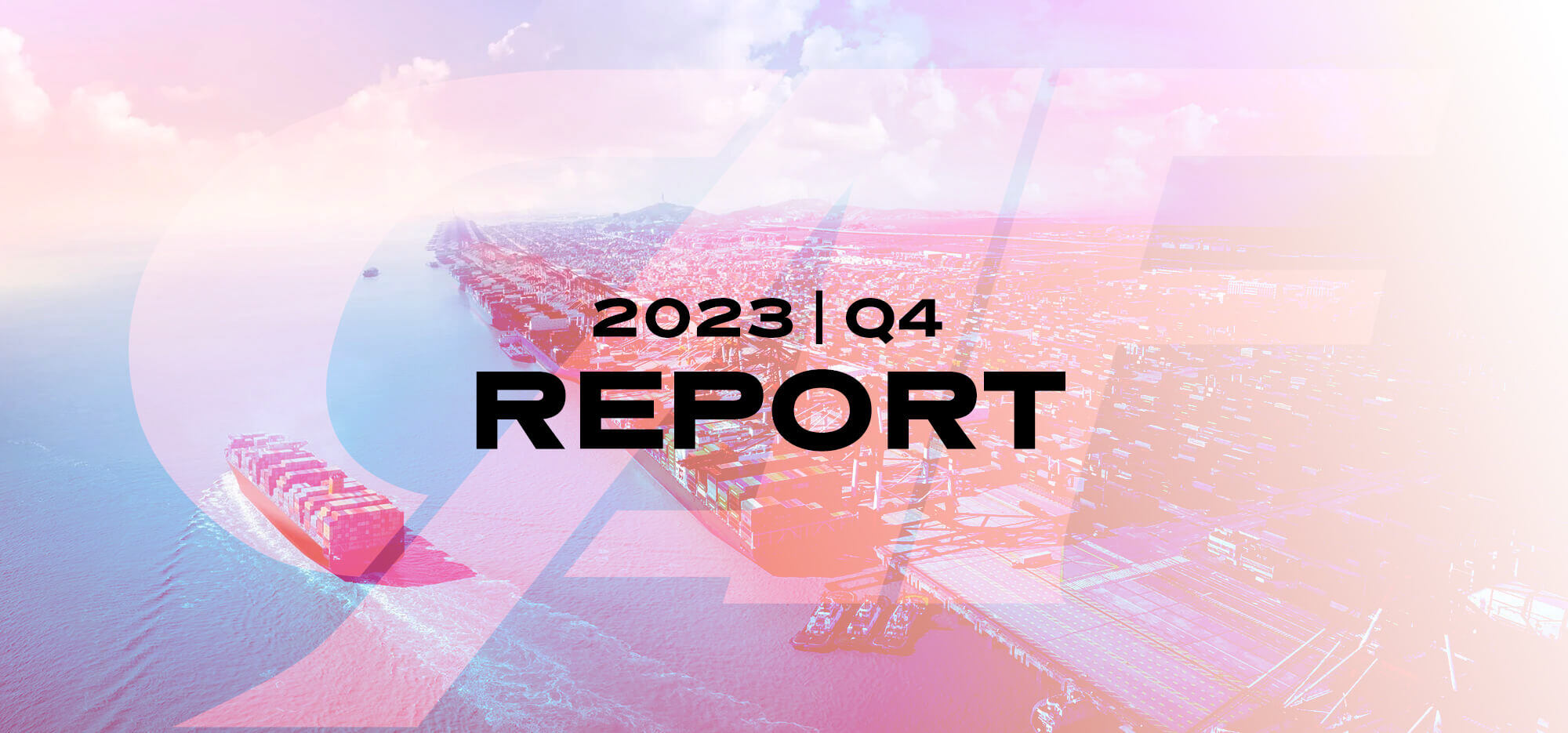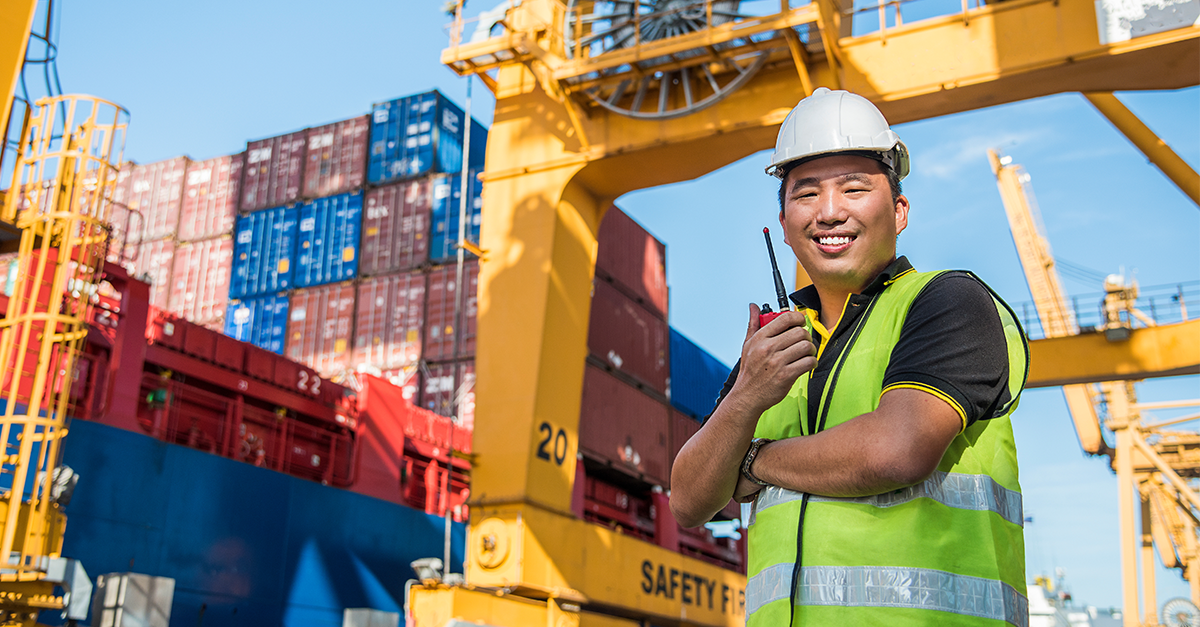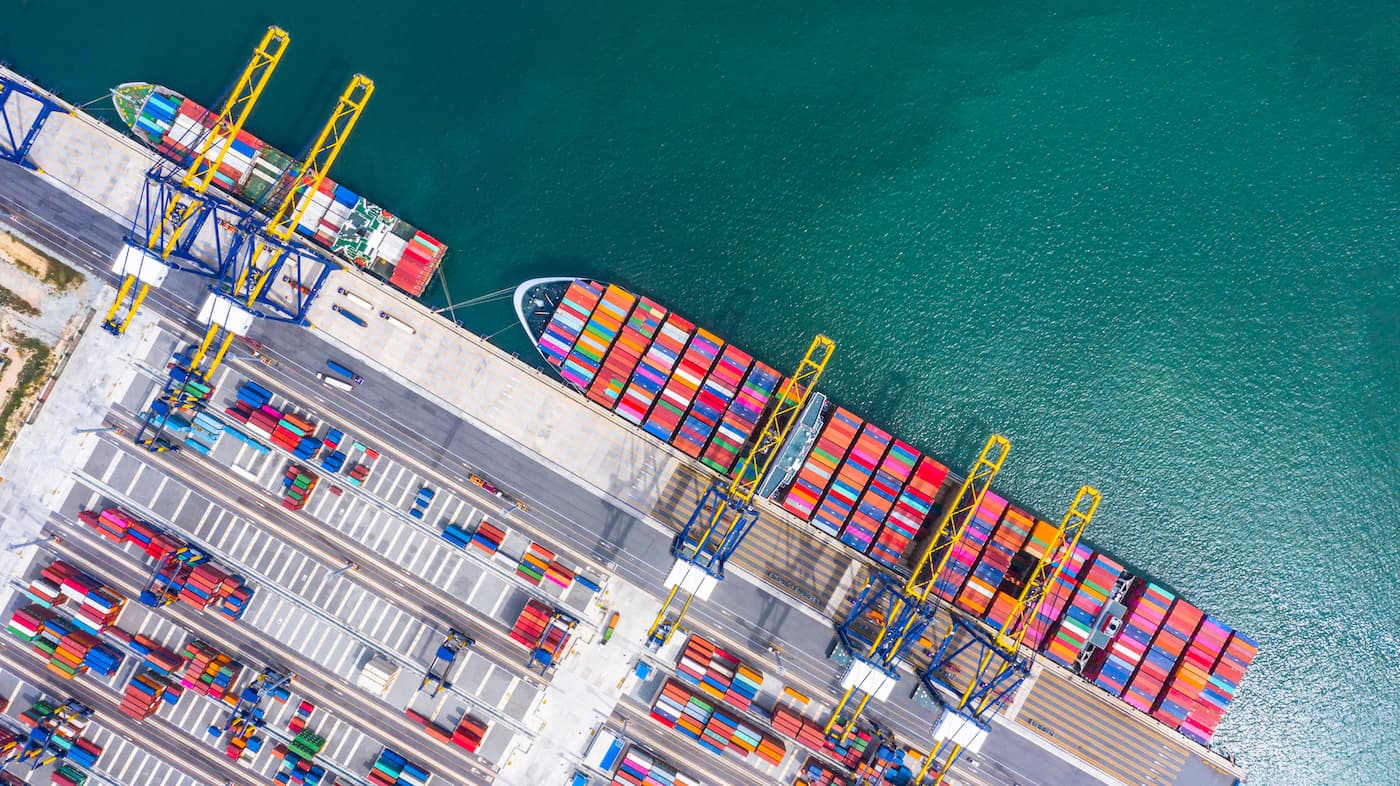As we close the curtains on a dynamic 2023 and set sail towards the uncharted waters of 2024, CAF Worldwide President and CEO Joe Barry presents an insightful review of the past year and a forward-looking perspective for the year ahead.
Part 1:
Reflections on 2023
In our reflections on 2023, we explore how the industry navigated a period of recalibration, emerging from the tumultuous post-pandemic years into a state of normalization. From the resurgence of blank sailings to the intricate dance of rate stabilization, and the nuances of navigating an uncertain economic landscape marked by inflation and consumer behavior shifts, 2023 was a year of strategic adaptation and resilience.
Resetting and Restructuring, plus Market Reaction
The year 2023 marked a significant transition for the logistics and freight industry, characterized by a shift from the chaos of the post-pandemic period to a more stable market environment. Joe Barry, President and CEO of CAF Worldwide, observed,
"In 2023, there was a return to normalization in the market," observes Joe Barry, President and and CEO of CAF Worldwide, while adding that this normalization came with its own set of challenges due to an overcorrection in market values. “The correction was somewhat overdone, as volumes decreased more than anticipated due to unexpectedly high inventory levels."
This led to a situation Barry describes as an "importer hangover," necessitating a focus on inventory reduction and cost control.
The industry's response was multifaceted, involving strategic efforts to reduce inventory levels and adjust to lower pricing demands across all sectors. Steamship lines played a significant role in this transition, as they significantly lowered their rates to counterbalance the high costs incurred in 2022. This rate reduction, though more than predicted, was crucial in contributing to a fragmented yet evolving environment. As a result, 2023 was a year of resetting for the industry, bringing the market back to, or even below, pre-COVID levels.
The Revival of Blank Sailings
Blank sailings, a practice where carriers cancel, skip, or void voyages, is not a new phenomenon in the shipping world. However, its increased prevalence in 2023 marked a notable shift from the patterns observed during the height of the pandemic.
"The industry anticipated an increase in blank sailings," said Barry, whose prediction in last year’s Q1 report certainly materialized, primarily among certain carriers. This reflected a strategic response to the evolving market conditions.
Dual Purpose of Blank Sailings
The rationale behind these blank sailings is twofold. On one hand, they serve to create additional demand within the industry by deliberately reducing available capacity. On the other hand, they aid carriers in cost reduction by not operating certain vessels.
This dual strategy plays a crucial role in balancing market dynamics.
"Blank sailings serve a dual purpose,” notes Barry. “Firstly, they create additional demand by reducing available capacity in the industry. Secondly, they help carriers reduce costs."
A poignant example of this strategy was a blank sailing on the Bangladesh route, coinciding with a vessel delay that led to two vessels arriving simultaneously.
"The cargo from the previous week, which was supposed to be on the canceled voyage, had to be accommodated on the next vessel," Barry recounts. This resulted in a scenario where there wasn't enough space for all the cargo, leading to delays in some shipments. While this incident did not massively disrupt the market, it underscored the strategic nature of blank sailings in creating temporary demand surges and managing logistical challenges.
Balancing Act Between Carriers and Importers
Carriers strategically employ blank sailings to manage rates and maintain profitability. It's a delicate balancing act, as carriers aim to keep rates profitable while importers seek the lowest possible rates.
"Carriers use blank sailings strategically to manage rates and maintain profitability," Barry points out. “This approach is a testament to the industry's adaptability and its ability to respond to changing market conditions with innovative strategies.”
Interestingly, the return of blank sailings in 2023 symbolizes a shift back to more traditional industry operations. During the peak of the pandemic, the demand for shipping was so high that every available vessel was utilized.
"Blank sailings are not a new tactic; they were prevalent pre-COVID," Barry notes, adding that their resurgence is indicative of the industry's return to a state of normalcy post-pandemic.
The Strategy Behind Capacity Elimination
The industry's approach to stabilizing plummeting rates was multifaceted. One key strategy, as Barry explains, involved the elimination of capacity from the market.
"The industry indeed saw efforts to eliminate capacity as a strategy to stabilize plummeting rates and maintain carriers' market shares," he notes. This approach was executed through two primary methods: blank sailings and the removal of redundant strings.
Blank sailings, as previously discussed, played a crucial part in these efforts. By canceling, skipping, or voiding voyages, carriers were able to temporarily remove capacity from the market. This tactic not only created additional demand but also helped in regulating the rates, balancing the scales between the supply and demand dynamics.
The Removal of Redundant Strings
Alongside blank sailings, another significant move was the removal of redundant strings from vessel routes.
"A string refers to a vessel's route stopping at various ports. When two vessels operate along the same string, one might be permanently withdrawn to reduce overall capacity," says Barry, adding that this more permanent solution offered a way to stabilize the market by adjusting the supply to better align with the demand.
The Goal: Market Stability
These actions, both temporary and permanent, were geared towards a singular goal: stabilizing rates in the market. By consciously reducing capacity, carriers aimed to prevent rates from plummeting, thus preserving their profitability.
"By reducing capacity, carriers aimed to prevent rates from falling too low," Barry explains, highlighting the importance of maintaining a balance in the industry.
The Fragmented Economic Landscape
The year 2023 was marked by significant concerns surrounding inflation and consumer confidence, which profoundly influenced the global economic landscape. Despite these concerns, the reality of the situation was more nuanced than a straightforward recession narrative.
"While there were concerns about inflation and consumer confidence, it's not accurate to say there was a recession in the technical sense,” observes Barry, adding that “the economic landscape in 2023 was notably fragmented, with some industries facing setbacks while others experienced growth.”
This varied impact was felt globally, but with regional differences. For instance, the U.S. economy showed more resilience compared to the global economy, diverging from the predicted recession due to high inflation rates.
The Shipping Industry's Unique Position
In the shipping industry, the impact of these economic factors took on a unique form. The over-inventory of importers somewhat masked the effects of consumer confidence and inflation.
"This excess inventory made it challenging to accurately gauge the impact of consumer confidence and inflation," he says, noting that retailers, equipped with ample stock, reduced their need for new imports, leading to a scenario that might be misinterpreted as reduced consumer demand.
Global Implications of U.S. Import Behavior
The behavior of U.S. importers had significant implications on a global scale. Their reduced purchasing affected production in other countries, creating a ripple effect across the global market. Interestingly, the ability of importers to sell from their existing inventory without the need for significant new imports contributed to a less recessionary appearance in the market.
"2023 was an anomalous year, almost warranting an asterisk," Barry remarks. “Shipments were down, but not to the extent indicative of a recession. The economic dynamics of the year led to a shift in spending, with consumers increasingly favoring experiential purchases over traditional goods. This shift highlights the changing patterns in consumer behavior in response to the broader economic environment.”
The Challenge of Accurate Forecasting
The uncertainty surrounding the potential impact of a non-occurring recession and the reopening of Chinese ports created a complex scenario for importers.
"The industry faced challenges in accurately forecasting demand due to the uncertain economic landscape," says Barry “This uncertainty was compounded by concerns over how the reopening of Chinese ports would affect the global shipping industry.”
Contrary to many predictions, the reopening of Chinese ports did not have the dramatic impact on the industry that was widely anticipated. There was a prevailing expectation that once China resumed business as usual, there would be a significant surge in volume, potentially overwhelming carriers and ports. However, this scenario did not unfold as expected, leading to a different set of market dynamics.
"Initially, there were predictions of a surge in volume, but this did not materialize," Barry notes, highlighting the unpredictability of the situation.
High Inventory Levels as a Key Factor
A pivotal factor in 2023 was the high levels of inventory maintained by importers. This abundance of stock played a crucial role in shaping the industry's response to the market's needs. Despite the absence of a recession, the market did not experience a significant boost in strength, primarily due to these high inventory levels.
"It was an unusual year where the industry could meet demands without facing significant challenges," Barry observes. This situation deviated from the norm, as the industry navigated the year without the need for an urgent scramble for goods or issues with getting supplies on vessels.
Adapting to Unpredicted Scenarios in 2023:
The Shipping Industry's Resilient Response
The year 2023 tested the shipping industry's agility in facing unpredictable scenarios, ranging from the reopening of Chinese ports to various global economic factors. Contrary to expectations, the industry navigated these challenges with a remarkable level of steadiness and resilience.
"From my perspective, the challenge was not a challenge." Despite potential triggers for industry-wide crises, such as space or rate issues, the shipping world managed to meet all its requirements efficiently. Barry notes the absence of major issues that traditionally bottleneck the industry, such as weather events or shortages in trucking and equipment in the United States.
A Surprisingly Steady Year
For Barry, 2023 stood out as a year of stability in an industry often characterized by its susceptibility to global shifts.
"Ports weren't overloaded, there was no struggle to keep up with the demand," Barry recounts, highlighting the smooth operations throughout the year. “This equilibrium was somewhat unexpected, given the industry's propensity for rapid changes in response to global events.”
However, Barry cautions against complacency, reminding us of the industry's cyclical nature. While 2023 was steady, this status quo is not guaranteed to persist.
"If the demand picks up, the status quo we saw this year won't exist next year; it will start to go back to a real norm," he predicts.
Barry also reflects on the industry's tendency to have a short memory, particularly during times of crisis. Rates, for instance, which were sky-high during the pandemic, eventually returned to pre-pandemic levels, defying expectations of a permanent change.
"People forget there will be issues with truckers in this country, there will be issues with the ports," he warns, emphasizing that logistical challenges are inevitable. The industry, therefore, must remain vigilant and adaptable, learning from past experiences to better prepare for future challenges.
As we look towards the horizon of 2024, the sentiment within the shipping industry reflects a blend of hope and realistic expectations. Reflecting on the challenges and lessons of the past year, Barry expresses a sense of readiness to embrace the future.
"Reflecting on 2023, it feels like everyone is ready to move on from it," he says. This readiness stems from the industry's resilience through the tumultuous times of 2022 and the subsequent period of recalibration in 2023.
Coming Soon in Part 2:
CAF's Outlook for 2024
As the shipping industry emerges from a year marked by recalibration and resilience, all eyes are on what 2024 might bring. In the upcoming Part 2, Barry shares his forecasts and insights for the next chapter in logistics and freight.
With a focus on the trends, challenges, and opportunities that could define the coming year, this segment promises to offer a deep dive into the anticipated market dynamics and strategic approaches. Part 2 will include a comprehensive outlook on rate trends, market stability, and the industry's preparedness to adapt to the changing global economic scene.
Don't miss this insightful exploration of what lies ahead for the shipping world in 2024.
Topics: News
CAF Worldwide has been a trusted leader in global logistics and freight forwarding since 1982, delivering tailored supply chain solutions with a focus on reliability, innovation, and customer-centric service. Specializing in industries such as apparel, footwear, and consumer goods, CAF offers comprehensive services including air and ocean freight forwarding, customs brokerage, intermodal transportation, warehousing, and RFID-based tracking. With a strong presence in Southeast Asia and Bangladesh, CAF ensures efficient, secure, and timely delivery for clients worldwide. Guided by core values of advocacy, loyalty, and integrity, CAF Worldwide is committed to advancing global trade through ethical practices and cutting-edge technology.













 Copyright 2025 CAF Worldwide. All rights reserved.
Copyright 2025 CAF Worldwide. All rights reserved.